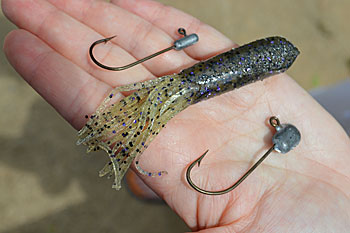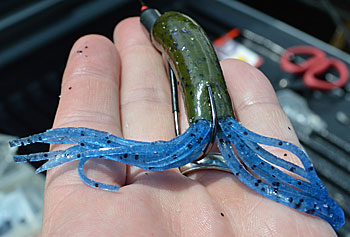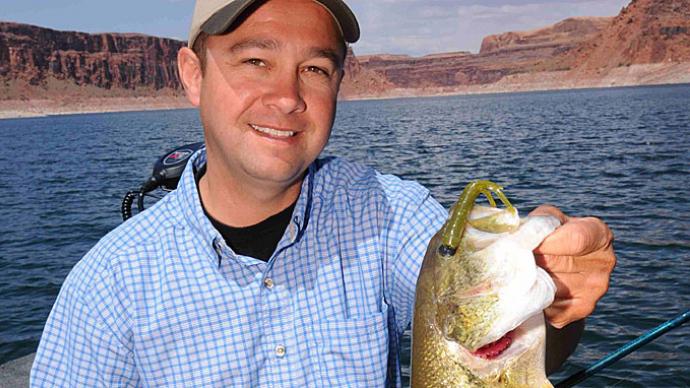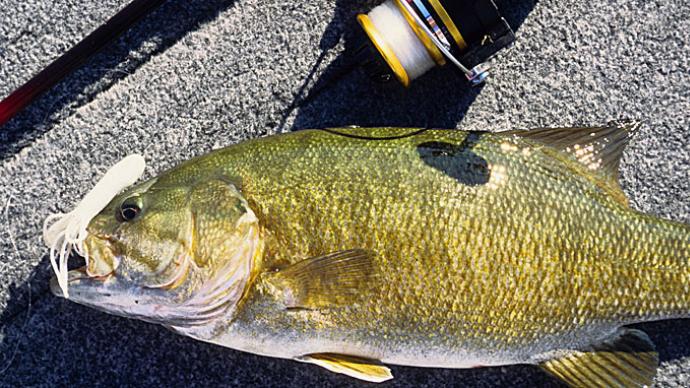
If you fish for smallmouth, you have tube baits in your tackle box or boat. And most likely, there are piles of them. No one will blame you for having so many. The simple baits, hollow and sport squid-like tentacles off the back, are one of the best smallmouth catchers ever designed. You can drag them across the bottom to imitate a crawfish or swim them throughout the water column to imitate a baitfish.
Tubes have come a long way since Bobby Garland introduced the Fat Gitzit almost 40 years ago. Miniature tubes, less than 1-inch long, have caught buckets of bream, crappies, and perch. Giant ones, more than 1-foot long, have caught many muskies and some spawning bass, especially in California lakes, where they grow large. And the 3- to 5-inch ones best known for catching smallmouth have caught plenty of largemouth bass, too.
Largemouth bite tubes because of their action and compact profile. Anglers like them because of their versatility. They can be rigged and fished from open flats in the spring or fall to thick piles of aquatic vegetation during the hottest summer months. They also work for bedding bass, one of their original applications. So if you have only been fishing tubes for smallmouth, here are five ways to catch largemouth on tubes.
Slow in the shallows
When Garland offered his Gitzit, there was one way to rig it. Take a specially designed lead-head jig, which features a 90-degree line tie, and insert it into the tube. Once you pushed it to the front of the tube, you poked the line tie through the plastic and tied it to lightweight monofilament line. That rigging method still catches bass today.
Rigging a tube with the weight inside creates a unique action, which changes depending on the shape of the lead-head jig. There are two basic shapes: flat and cylindrical. Rig a flat one, and your tube will glide and slowly spiral as it falls. It also makes your tube move unpredictably when you pull it. That extra movement attracts largemouth, but it can cause problems when you fish around aquatic vegetation because it will swim into it and foul. If that’s the case, switch to a cylindrical-shaped one, which keeps tubes moving in more of a straight line.
Smallmouth anglers use this rigging method for hopping tubes down rocky backs or dragging them across rock piles and shoals in the Great Lakes. It also is a great way to catch largemouth when they are shallow, and the cover is relatively sparse.
One of the best situations is where a rock bank falls into an inside weed line. Look for points and pockets in the grass, and cast to them, letting the tube settle next to them. Tubes work around docks and seawalls, sunken cribs, and Lincoln Log-style boxes of timbers filled with rock and support docks in Northern lakes. While letting a tube slowly sink next to one is a great way to get a largemouth to bite, look for unused ones around and between docks. The cribs are left on the bottom when a dock or boathouse is torn down. They create open spots within a weed bed that attract schools of largemouth.
You’ll want your crawfish-colored tube near the bottom, so choose a weight corresponding to your fishing depth. If it’s shallow — say less than 10 feet — stick with one that weighs 1/16- or 1/8 ounce. Go heavier as the water gets deeper. Let it carry your tube to the bottom, and then work it with sharp pulls of your rod’s tip, letting the tube fall on a semi-slack line. That will ensure it has the freedom to glide.
This fishing method calls for a spinning rod. A medium power, fast action 7-foot rod is about perfect. Err on the side of a larger spinning reel. The bigger spool will reduce line twists and wind knots and incorporate a larger, smoother front drag. Fill it with 6- to 10-pound test fluorocarbon or low-stretch mono. Braid of equivalent diameter — usually rated 30-pound test or less — will work, too.
Swim them
Most anglers focus solely on the bottom when using a soft-plastic lure rigged on a lead-head jig. But just like that’s a mistake when fishing a bass jig, it’s a mistake with a tube. Its size and unpredictable action make it a great baitfish imitator when you swim it off the bottom with steady reeling and twitches of the rod’s tip.

The key to swimming a tube is using the right-sized lead-head jig — 1/8-ounce is about perfect. If the wind is blowing or you need more casting distance, don’t hesitate to use a ¼-ounce version. You don’t need to go super light with the weight because you want to move the tube quickly. It will be out in the open, and you don’t want largemouth getting a good look at it.
Use a spinning rod and 8- or 10-pound test line. Choose shad-colored tubes, such as pearl or clear with silver flake, or perch colored such as green pumpkin candy. And it never hurts to dip the tails in chartreuse, regardless of where you swim it.
In many Northern lakes, sandy flats with some grass are common places for yellow perch to school. Both species of bass found there eat them. While smallmouth swim wherever the perch go, largemouth will wait closer to cover, such as a weed edge or rock pile. Under low-light conditions, such as early or late in the day or under overcast skies, largemouth will swim farther from cover to grab a tube. Cast your tube parallel to the cover if it's midday or sunny.
Starting in the fall and continuing through winter, Southern largemouth chase shad as they school in the warmer water found toward the back of creeks. They’ll herd baitfish against a bank, point, or other piece of structure and blast through them. You often see them grab shad that they have pushed against the surface. Cast your tube past the schooling largemouth, and swim it back through them to generate strikes.
Rip them
Most anglers view tubes as finesse baits. They say bass eat them because they act natural, quietly swimming through the clear water. But don’t discount their power to generate reaction strikes.
Lipless crankbaits are great for catching bass in submerged aquatic vegetation. Run the lure into the grass, pop it free and wait for the strike. You can create those same strikes with a tube, giving largemouth a different look. Using no-stretch braided line, cast your tube and let it settle into the vegetation. Then snap your rod up, quickly pulling the bait from the grass and letting it settle back into the grass.
You’ll need a lead-head jig that sports a thin wire hook, which requires less effort to rip through the grass. It’s OK to fish a heavier jig head, say 3/8- or even ½-ounce. This isn’t a subtle tactic; you want the lure to get down there.
If you want to give largemouth more reason to react, add a rattle to the tube. Heads with molded rattles are available, but the extra bulk can make inserting the jig a little more difficult. Instead, use one of the small glass rattles designed for plastic-worm fishing. You can glue them to the hook shank directly behind the lead head. If you want a more permanent attachment and own a fly vise, wrap some thread around the rattle and then cover it with head cement.
A fast-action spinning rod will rip tubes from the grass, but a casting rod gives you more power. If water clarity demands a monofilament or fluorocarbon leader, keep it on the short side. You want the lure to react as soon as you pop the rod. The stretch in extra monofilament slows that.
Hunt heavy cover
Denny Brauer is the master of jig fishing. And if you heard he won the 1998 Bassmaster Classic by flipping and pitching to laydowns in 2 feet or shallower on North Carolina’s High Rock Lake, chances are good you’d bet your bottom dollar that he had a jig tied on his line. Unfortunately, you would lose that cash. He was fishing a Texas-rigged tube.

Brauer’s feat took the fishing-tackle industry by storm, with soft-plastic manufacturers adding flipping tubes to their catalogs almost as soon as the trophy was presented. But it shouldn’t have been such a surprise. In 1997, Arkansas pro Doug Garrett flipped a Texas-rigged tube on his way to winning that year’s Bassmaster Megabucks. He won Megabucks again the following year, though he fished a jig and pork frog.
Tubes may be the perfect lure for flipping and pitching heavy cover. They have smooth sides, and their tentacles aren’t solid or long enough to wrap around the cover. They still slide into the smallest spots, even with a large bullet-shaped weight on the front. While Brauer used one around wood cover, tubes shine when fishing for largemouth buried in thick vegetation.
You’ll need to peg the weight, which can be as heavy as you need. Use a big, wide-gap hook because the hook will need to handle a lot of extra plastic when you set the hook. To mediate some of that, instead of driving the hook back through the plastic, put it through the tails and then skin hook the point in the top of the tube. It will remain weedless, but the hook will pop out easier when you set the hook.
Don’t commit to only using the larger flipping tubes. The 4-inch tubes fished for smallmouth can be flipped, too. Adjust your hook and weight accordingly. This is especially effective when largemouth are keying on small baitfish or living in tidal-river systems, where they prefer little lures.
Take them to the top.
There aren’t many structural differences between a topwater frog and a Texas-rigged tube. They both are hollow. They both have appendages off the back. They both have hooks that point upwards. And they both generate explosive surface strikes.
A tube won't outfish a frog when largemouth are on a frog bite. But if those bass are only playing with a frog, bumping it out of the way without eating it, then a tube can change them into biters. That’s because you can drag it across the vegetation and let it slide into the holes. Bass won’t be able to resist eating it when it falls into their face.
Use strong braided line, as heavy as 65-pound test. You may want to add a small bullet sinker, like 1/16 ounce. That will ensure the tube heads down into openings. Use white or bubble-gum-colored tubes, which are easier for you to see. The bass are usually keyed in on the commotion on top of the matted grass. Even if they could see your tube, they couldn’t care less about its color.




